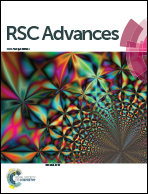Europium doping effect on 3D flower-like SnO2 nanostructures: morphological changes, photocatalytic performance and fluorescence detection of heavy metal ion contamination in drinking water
Abstract
Pure and Eu-doped (1, 3, 5, 7 & 10 mol%) SnO2 nanostructures have been successfully synthesized by a facile and simple hydrothermal method. The properties of as-synthesized samples have been investigated by various analytical techniques. It was found that the morphology of as-synthesized flower-like SnO2 nanostructures made of intermingled small-size agglomerated nanorods can be precisely controlled by varying the Eu dopant concentration in a reasonable range. Moreover, the photocatalytic activity of SnO2 studied by the degradation of rhodamine-B (RhB) dye in aqueous media shows excellent performance on 10 mol% europium doping, which may be attributed to its specific morphology and larger surface area as seen from BET measurements. Furthermore, sensors based on 10 mol% Eu-doped SnO2 nanostructures show the highest fluorescence quenching efficiency (0.23) as compared to pure SnO2 and other doped samples for the lowest concentration of Cd2+ (10 ppb) in drinking water with a Limit of Detection (LOD) as low as 7 ppb; 0.007 μg mL−1. The formation mechanism of Eu-doped SnO2 nanostructures has been discussed in detail.



 Please wait while we load your content...
Please wait while we load your content...